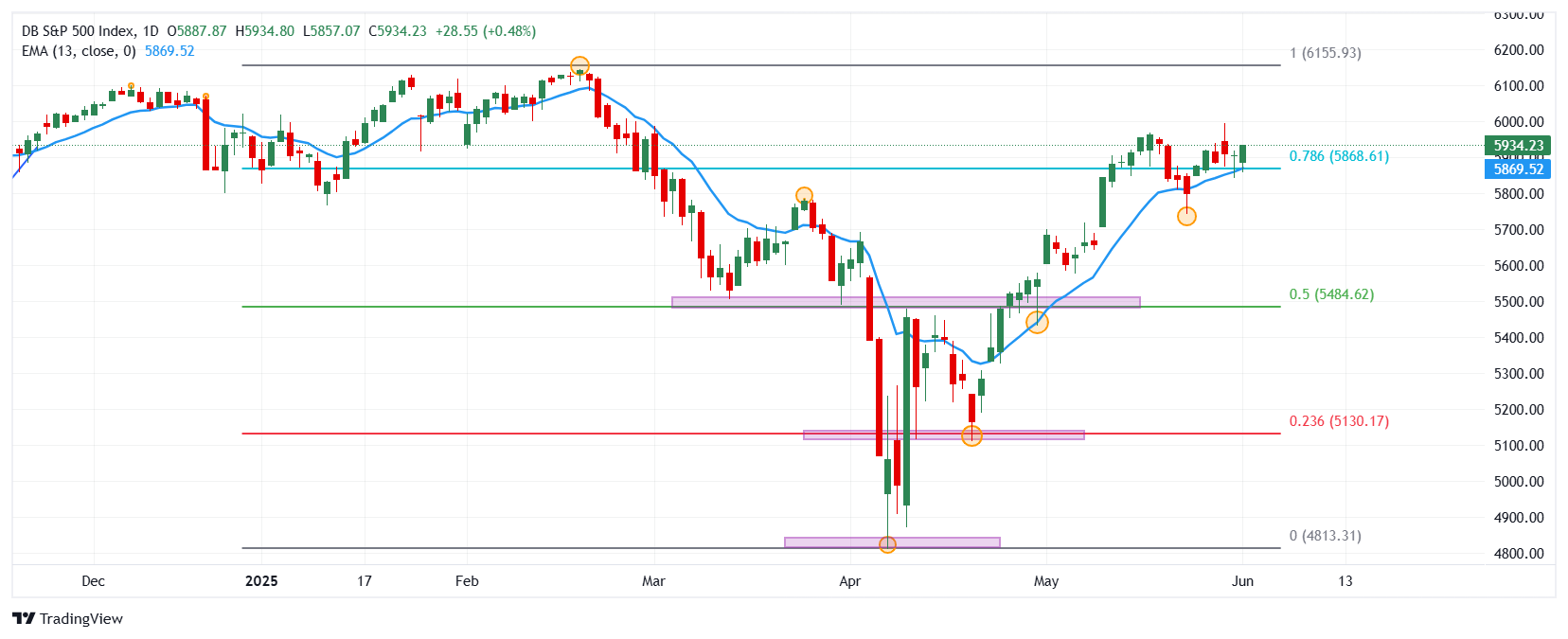- The S&P 500 stock index rebounds 0.48% in the day, reaching May 29 in 5,934.
- Donald Trump announced the tariff imposition of 50% to aluminum and steel, climbing commercial tensions.
- The ISM manufacturing PMI was 48.5 points in May, worsening analysts’ estimates.
- The president of the Federal Reserve of Chicago, Austan Glasbee, was optimistic when pointing out that the Central Bank will eventually lower interest rates, once the tariff uncertainty is cleared.
- Steel Dynamics (STLD) titles rebound 10.27%, reaching maximums not seen since December 5, 2024 in 142.42 $.
The S&P 500 established a minimum of the day in 5,857, finding aggressive buyers that promoted the maximum index of May 29 in 5,934. Currently, the S&P 500 operates over 5,934, winning 0.48% today.
The S&P ends Monday on positive terrain despite commercial tensions
Based on the information presented by the Institute of Offer Administration (ISM), the manufacturing PMI that was located at 48.5 points in May, disappointing the 49.5 estimated and located below the 48.7 registered in the previous month.
On the other hand, Austan Golsbee, president of the Federal Reserve of Chicago, mentioned in his speech today that the fees can go down in 12-18 months, after resolving the tariff uncertainty.
The president of the United States, Donald Trump, announced the imposition of 50% tariffs on aluminum and by increasing commercial tensions.
In this scenario, the S&P 500 advances 28 points, climbing 0.48% today, visiting maximum of May 29 in 5,934. The Steel Dynamics (STLD) shares lead the profits in the index, rebounding 10.27%, reaching maximums not seen since December 5, 2024 in 142.42 $.
Levels to be considered in the S&P 500
The S&P 500 reacted upwards from a short -term support given by the minimum of May 23 in 5,742. The following key support is in 5.430, given by the minimum of April 30 in convergence with the exponential mobile average of 13 periods. Upwards, the important resistance is in 6,145 maximum of February 19.
S&P 500 DAILY GRAPH

S&P 500 FAQS
The S&P 500 is a very often stock index that measures the yield of 500 public companies and is considered a wide measure of the US stock market. The influence of each company on the calculation of the index is weighted based on stock capitalization. This is calculated by multiplying the number of bought shares of the company for the price of the action. The S&P 500 index has achieved impressive yields: 1.00 $ invested in 1970 would have produced a yield of almost $ 192.00 in 2022. The average annual profitability since its creation in 1957 has been 11.9%.
Companies are selected by Committee, unlike other indices that are included based on established standards. Even so, they must fulfill certain eligibility criteria, the most important of which is stock market, which must be equal to or greater than 12.7 billion dollars. Other criteria are liquidity, domicile, stock capitalization, sector, financial viability, quotation time and representation of the sectors of the United States economy. The nine largest companies in the index represent 27.8% of the stock market capitalization.
There are several ways to operate with the S&P 500. Most of the Stred Betting retail runners and platforms allow operators to use contracts per difference (CFD) to make bets on the price direction. In addition, indexed funds, investment funds and quoted funds (ETF) that follow the price of the S&P 500 can be purchased. The most ETF liquid is the ETF of the London Stock Exchange. The most ETF liquid is the State Street Corporation Spy. The Chicago Mercantile Exchange (CME) offers futures contracts on the index and the Chicago Board of Options (CMOE) offers options, as well as ETF, ETF Inverse and ETF leverage.
There are many factors that promote S&P 500, but mainly it is the aggregate performance of the companies that compose it, revealed in their reports of quarterly and annual results. American and world macroeconomic data also contribute, since they influence investors’ confidence, which is positive drives profits. The level of interest rates, set by the Federal Reserve (FED), also influences the S&P 500, since it affects the cost of credit, which is largely depending on many companies. Therefore, inflation can be a determining factor, as well as other parameters that influence the decisions of the Federal Reserve.
Source: Fx Street
I am Joshua Winder, a senior-level journalist and editor at World Stock Market. I specialize in covering news related to the stock market and economic trends. With more than 8 years of experience in this field, I have become an expert in financial reporting.





